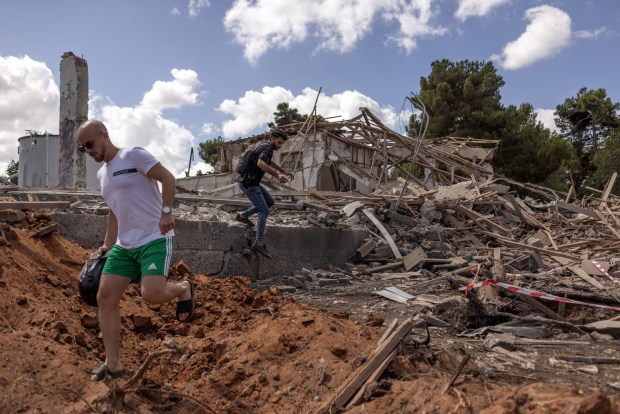War is unpredictable, but recent developments in the Middle East conflict have precipitously narrowed the options for key players. Contrary to Israeli Prime Minister Benjamin Netanyahu’s claims, it leaves no possible path to peace.
For a year, U.S. officials have implored the warring parties to avoid further escalation and pursue diplomatic solutions. They have specifically warned Israel against escalating its conflict with Hezbollah on the border with Lebanon into a second front in the war. But that is exactly what Netanyahu decided to do last month.
Israel had good cause to try to neutralize Hezbollah, as tens of thousands of Israeli civilians have had to flee the militant group’s ongoing attacks over the past year. But that justification doesn’t change the fact that more war, not less, is now on the horizon.
Using thousands of pagers and hundreds of walkie-talkies as mini-bombs across Lebanon, followed by dozens of airstrikes, Israel has killed scores of senior figures of the terrorist group, with ample civilian collateral damage. More than 1,000 people are already dead and more than 1 million displaced across Lebanon. It is also the first time in nearly two decades that Israel has struck central Beirut and conducted a ground invasion into the south.
When Iran fired nearly 200 ballistic missiles on Israel Tuesday, it was undoubtedly a further escalation. This was only the second time Iran, which has traditionally worked through proxy militias, has ever directly attacked Israel this year. President Joe Biden noted that the attack was “defeated and ineffective,” since Israel, with American help, managed to intercept most of the missiles and prevent any Israeli casualties, just as it had in April when Iran attacked Israel directly for the first time. Even so, this was a more serious and dangerous effort than in April, with more advanced weaponry and no early warning. This time, Iran meant it. But it still failed to land a punch.
From the perspective of the Iranian regime, it had to try. Iran’s reach in the region is through its proxy militias, and Israel has taken a hammer to them. Iran’s Revolutionary Guard Corps said Iran’s attack was in retaliation for Israel’s assassination of Hezbollah’s longtime leader Hassan Nasrallah in a strike in Beirut last week, and Hamas’ leader Ismail Haniyeh in a guesthouse in Tehran in July.
But Israel’s assault on Iran’s proxies goes far beyond the leadership. Hamas has been cowed by a yearlong scorched-earth assault in Gaza, and Israel’s recent actions in Lebanon have pummeled Hezbollah, Iran’s strongest and most well-armed nonstate ally.
Iran would have lost all credibility with its “axis of resistance” partners had it failed to respond, but in doing so, Iran revealed its limitations.
So what’s next? Unlike after Iran’s failed attack in April, no one is telling Netanyahu to “take the win” this time. Both Israel and the United States have promised that Iran will pay.
Iran, meanwhile, is looking at a world where Israel’s military and intelligence advantage is proving overwhelming. If neither its proxies nor its own military capacity can still project power and deter attacks, nuclear weapons are probably looking as attractive as ever to the Islamic Republic. And the state is believed to be within reach of producing them.
Editorial: In the Middle East, a terrifying scenario becomes all too clear
Neither the United States nor Israel is ready to allow that. This means that the next logical step in this chain of events is likely Israel, probably with U.S. support, striking nuclear facilities inside Iran, thereby sparking the all-out war that so many have feared for a year.
For Netanyahu, and many hawks in the U.S. foreign policy establishment, this is the moment they’ve been hoping for. Iran and the groups that act as its muscle in the region are all on the back foot. What better time to strike?
But overwhelming military advantage doesn’t necessarily translate to a quick and clean war. The United States learned that lesson in Iraq. It doesn’t even guarantee success is preventing Iran from going nuclear. And the civilian harm would surely eclipse the horrific suffering we’ve already seen in Gaza.
Most importantly, though, this path has no endgame. The conflict undergirding the region’s instability would remain intact. At best, it would contain threats for a period of time. More likely, it merely spawns more.
As has been the case for years before this war and every day since, the only path to lasting peace, for Israel and all its neighbors, is political resolution of the Palestinian question. Even if Israel succeeded in toppling Iran’s destabilizing regime (an unlikely outcome but likely Netanyahu’s ultimate aim), what then? The deep traumas that this region’s people have faced will continue to fuel extremism for a population that is offered no better options.
Will anyone have the power and courage to pull either side back from the brink before it’s too late? Momentum is narrowing that window. The U.S. electoral timeline seriously diminishes the chance that America will play that role effectively, at least until January.
Does leadership in Iran or Israel realize how fraught the path ahead is? The world can only hope.
Elizabeth Shackelford is senior policy director at Dartmouth College’s Dickey Center for International Understanding and a foreign affairs columnist for the Chicago Tribune. She was previously a U.S. diplomat and is the author of “The Dissent Channel: American Diplomacy in a Dishonest Age.”
Submit a letter, of no more than 400 words, to the editor here or email letters@chicagotribune.com.



